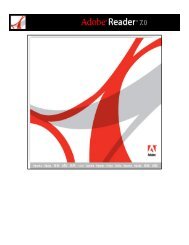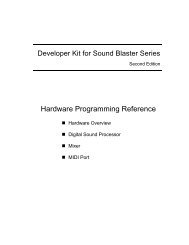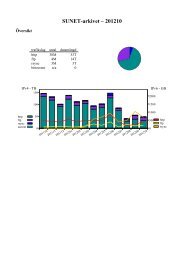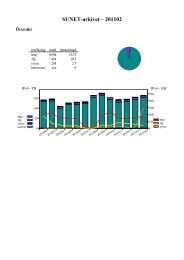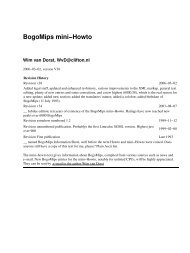Audio Codec '97 Revision 2.1
Audio Codec '97 Revision 2.1
Audio Codec '97 Revision 2.1
Create successful ePaper yourself
Turn your PDF publications into a flip-book with our unique Google optimized e-Paper software.
AC ‘97 Component Specification <strong>Revision</strong> <strong>2.1</strong><br />
D.6.5 Signal Rise and Fall Times<br />
BIT_CLK<br />
SYNC<br />
SDATA_IN<br />
SDATA_OUT<br />
Trise clk<br />
Trise sync<br />
Trise din<br />
Trise dout<br />
106<br />
Tfall clk<br />
Tfall sync<br />
Tfall din<br />
Tfall dout<br />
Figure 40. Signal Rise and Fall Timing Diagram<br />
Parameter Symbol Min Typ Max Units<br />
BIT_CLK rise time Triseclk 2 - 6 ns<br />
BIT_CLK fall time Tfallclk 2 - 6 ns<br />
SYNC rise time Trisesync 2 - 6 ns<br />
SYNC fall time Tfallsync 2 - 6 ns<br />
SDATA_IN rise time Trisedin 2 - 6 ns<br />
SDATA_IN fall time Tfalldin 2 - 6 ns<br />
SDATA_OUT rise time Trisedout 2 - 6 ns<br />
SDATA_OUT fall time Tfalldout 2 - 6 ns<br />
Note 1: 50 pF external load<br />
Note 2: rise is from 10% to 90% of Vdd (Vol to Voh)<br />
Note 3: fall is from 90% to 10% of Vdd (Voh to Vol)<br />
Table 60. Signal Rise and Fall Time Parameters<br />
AC ’97 <strong>2.1</strong> maintains the original specified BIT_CLK, SYNC, SDATA_OUT, and SDATA_IN signal rise and fall<br />
times. These signals must also meet the new Output Valid Delay time with respect to the rising edge of BIT_CLK<br />
specified in Table 57.<br />
Modeling of the AC-link output pin drivers should include rise and fall times, flight times, and external capacitive<br />
loads, which could be a large as 70 pF. Special consideration should be given to the BIT_CLK output pin driver for<br />
any Primary <strong>Codec</strong> that is designed to operate in multiple <strong>Codec</strong> and/or riser implementations.<br />
System designers should be aware that point-to-point routings with low total capacitive loads might require EMI<br />
reduction techniques, such as series resistors.<br />
May 22, 1998




